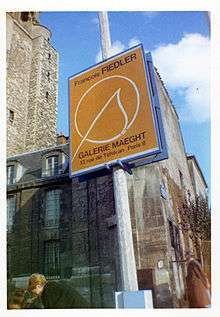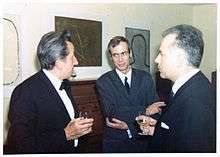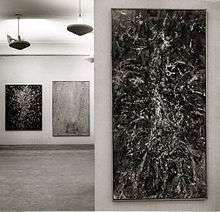François Fiedler
François Fiedler (1921–2001), born Fiedler Ferenc, was a Czechoslovakia-born French painter and printmaker.[1] He was an artist in the Aimé Maeght stable,[2][3] which included Marc Chagall, Alberto Giacometti and Joan Miró.




Biography
Fiedler was born in Košice, Czechoslovakia (now Slovakia),[4] in 1921.[5]
After receiving a Masters in Fine Arts degree from the Academy of Budapest, François Fiedler moved to Paris with his first wife in 1946. She died six months later, leaving him alone in a country where he barely spoke the language and had no friends. To make money, he made sanctioned reproductions of famous paintings for museums, as well as small figurative paintings of his own.
He met his second wife, Claire, with whom he lived in a small house in the forest south of Paris. One day while looking at a pot of house paint, crackled by the sun, he decided to reproduce this process on canvas. After this move, he ceased his figurative painting, finding expression in his new technique.
Joan Miró saw one of these paintings in a gallery and was impressed. He sought out the artist, and so met Fiedler; they became close friends, and Miró presented him to the prominent gallerist and art dealer Aimé Maeght. Through Maeght, he became close with Giacometti, Braque, César, Ubac, Tal-Coat, Miró, Chagall, and many other artists of this era.
During his long career, Fiedler was regularly featured in salon shows alongside his contemporaries, and his works were a regular feature in the Maeght Foundation publication Derrière le miroir.
As many young collectors did not have the money to buy an oil painting, he tried to find a way to convey in etchings that which he had achieved in oils. He started a series of etchings, some in very limited editions.
Aimé Maeght had told Fiedler that he was "next in line" to be made famous; in 1981 Maeght died before Fiedler could reach that level of notoriety. Following the death of Maeght, Fiedler found a patron in the art photographer Daniel Kramer, who supplied Fiedler with paint and canvases, while also serving as Fiedler's manager, photographer and publicist.
Fiedler died in Saint-Germain-Laval, Seine-et-Marne, France, in 2001, leaving behind a body of work including oil paintings, monotype prints, and etchings.
Fiedler's works can still be seen in museums and galleries, including the Maeght Foundation in Paris[6] and the Guggenheim Museum in New York City.[7]
References
- Aimé Maeght, Fondation Maeght Le noir est une couleur: hommage vivant à Aimé Maeght : 30 juin-5 2005 Page 243 "François Fiedler (Kosice-Kasa, Hongrie. 1921 - Gardeloup, 2001) Né dans les Carpates, François Fiedler commence à peindre à l'âge de 10 ans. Après des études universitaires il entre à l'Académie des beaux-arts de Budapest. En 1945, il ...
- "FIEDLER Francois Presentation". Aime Maeght Foundation. Fondation Maeght.
- Champetier, Michelle. "Francois Fiedler notes of biography". print, lithograph, etching, drawing, illustrated book.
- Košice (Kassa) was part of Austria-Hungary until 1918, which is why sources sometimes incorrectly refer to it as Hungary or Austria. In 1918, it became part of Czechoslovakia.
- "Fiedler Foundation". Fiedler Foundation. 28 December 2014. Retrieved 12 January 2020.
- Vaché, Julien. "Paris: Is there an "Art District" in Paris? And what are some of the best Contemporary Art galleries in Paris?".
- Makláry, Kálmán. "François FIEDLER".